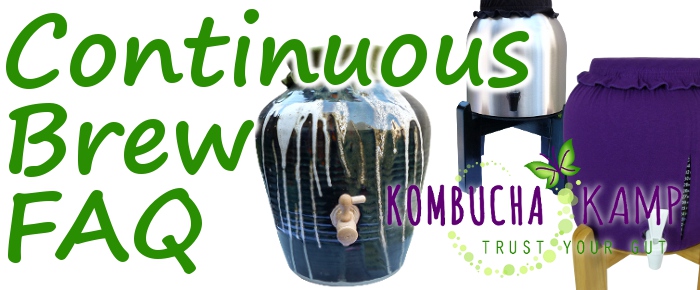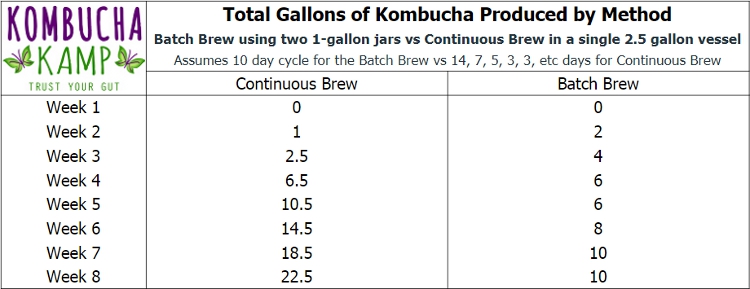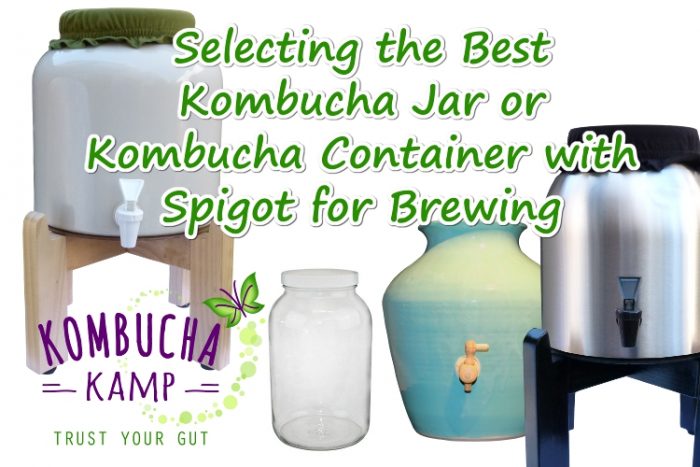Continuous Brew Kombucha FAQ
Got questions about the Continuous Brew process? Still not sure how CB works or whether it’s right for your home? The Continuous Brew Kombucha FAQ below can help!

If you’re still not sure, check out these other great pages:
- Continuous Brew vs Batch Brew Explained
- Continuous Brew Information & Testimonials
- How to Select a Continuous Brew Vessel
- Continuous Brew Packages
How does CB work?
CB flips the ratio of starter liquid and SCOBY to sweet tea. What that means is…
BATCH BREW: 90% sweet tea with 10% starter liquid and SCOBYs
VS.
CONTINUOUS BREW: 25-50% sweet tea to 50-75% already fermented Kombucha and SCOBYs (aka starter liquid)
BATCH BREW: 1 gallon KT every 7-14 days
VS.
CB: 1 gallon KT every 2-5 days (after initial batch)
What size is recommended? Can I make a 1 gallon CB?
Size matters! Between 2 and 5 gallons is the ideal vessel capacity for CB home brew. This allows enough space for the buildup of SCOBY and strong starter liquid, while still allowing you to decant 1-1.5 gallons of Kombucha for drinking. We do not recommend a CB of less than 2 gallons as it is difficult to maintain proper balance between the bacteria and yeast, leading to off flavors. Vessels larger than 5 gallons are difficult to handle physically and have their own flavor problems.
How much does CB make vs Batch Brew?
Continuous Brew allow for making a lot more Kombucha over time, but of course the exact amount depends on your personal taste preference and brewing cycle. The chart provides a sample comparison.
What happens with the Sugar?
Sugar is a required part of the fermentation process as it feeds the microorganisms. However, much of the sugar has been converted to healthy acids during the brew process. With Continuous Brew, the large amount of SCOBY and strong starter liquid already in the vessel get to work quickly on the sugar, accelerating the breakdown process. A small amount is left behind, which mixes with the healthy acids to make the drink a delicious balance with just enough sweet to balance the sour.
I don’t want to take on more work.
Actually, CB results in less work, less mess, and less stress!
- Clean vessel and refresh culture only once every three to six months vs every week (as in Batch Brewing) – less time cleaning!
- Kombucha flows from the spigot to the bottle for easy decanting – no funnels, no mess!
- Ebb and flow; if you need to take a break, the CB vessel acts as its own SCOBY Hotel. Upon return, you can produce fresh booch in just a few days – less fuss!
Can I customize the flavor?
CB is completely under your control. You decide when the flavor is right and harvest. Tasting from the spigot makes it a breeze. Then wait and make more only when you’re ready. The flavoring process is identical to batch brew and decanting into the bottle is also done via the spigot. Learn more about flavoring Kombucha here.
Why is CB safer than vs Batch Brew?
CB is safer because we rarely touch the cultures or even expose them to the air longer than it takes to pour in new sweet tea. Also, because we leave so much strong Kombucha and SCOBY in the vessel, the pH is always low, even after adding sweet tea. These two factors make the chances for mold or contamination nearly zero!
It’s actually healthier?
Longer Kombucha brews have more variety of healthy acids, but they’re also very sour, which makes them hard to enjoy! Continuous Brew allows for a mix of younger and older Kombucha, tempering the flavor but still producing those longer fermented acids. Plus some research shows that feeding the brew every few days boosts the production of those organic acids.
Will I have to top off right away? I’m not ready for more Kombucha yet.
Not at all. There is no need to refresh immediately unless you are drinking a gallon or so a week. So if you are just one person or would like to take a break, simply wait until you are a few days from needing more and then top off – the CB booch flows with your roll.
How long can I leave it in the CB before adding more sweet tea?
When taking a break, the CB vessel acts as its own SCOBY Hotel. Start the brew back up whenever you are ready for more booch. But keep it at least 25% full of Kombucha and SCOBY at all times, more if you like. The cultures need to remain saturated in liquid to protect against mold. It’s easy to check on the levels by peeling back the cap. If the level of the liquid has dropped, then refresh with sweet tea until you are ready to start it up again.
Won’t the SCOBYs die if you don’t feed them all the time?
SCOBYs are home to the bacteria and yeast. (Kombucha SCOBY Explained Here). To prevent drying out and mold, the SCOBYs must remain in plenty of Kombucha in the vessel. Eventually, the bacteria and yeast may die if not fed, but they can survive for many months as long as they remain submersed in the Kombucha. If you are taking a CB break for more than 3 months, consider adding some sweet tea now and then to refresh the brew.
Really? You’re telling me it’s fun?
Having your own Kombucha On Tap in the kitchen is fun! Making special flavors for your family and friends based on their favorites is fun! Spending your time enjoying the booch instead of doing weekly cleaning and maintenance is fun!
I’m nervous. Is it hard?
Not at all! As easy as Batch Brewing is, Continuous Brewing is even easier! The weekly process is reduced to decanting from the spigot and adding sweet tea.
I heard it will get too sour. How do I fix that?
Easy peasy! Drain some sour Kombucha out (note: set aside for use as Kombucha Vinegar aka “KV” with loads of uses). Then top off with sweet tea and you’re back to your preferred Kombucha flavor in just a couple of days! A few times a year, once too much SCOBY has built up, you will clean out and re-set the vessel entirely. But you will always be able to re-start using the same SCOBY and liquid from the previous brew.
What do you do if the spigot gets clogged?
Sometimes SCOBY or yeast can clog the spigot. No worries, all KKamp spigots include a small spigot brush which quickly and easily removes the blockage. If you do not have a brush, you can use a toothpick or paperclip to pick out the obstruction. Every once in a while, the problem is that a culture has moved down in the vessel and is physically blocking the opening – to fix that, simply use your hand to move the culture aside and the spigot will flow again. Another solution may be to switch to a spigot with a wider opening and flow which makes it less likely to clog, such as the stainless steel spigot here.
Will I ever have to clean it?
The CB vessel will need some routine maintenance about 2-3 times a year, and only when the flavor of the brew is compromised. That means, as long as you are enjoying the Kombucha, you don’t have to clean the vessel. However, if the brew is too sour to enjoy right after adding sweet tea, or there is just too much SCOBY in the vessel to allow for enough brew, it’s time for a cleaning. Every KKamp CB Package includes free video instructions, or you can find those videos here.
Do I add the flavoring directly to the vessel?
No! Just like batch brew, we flavor directly in the bottle. We never add flavors to the primary fermentation with the SCOBY/mother. Follow these easy flavoring steps!
Won’t there be too much yeast coming out of the spigot at the bottom?
It’s true that yeast rest at the bottom, but the spigot only needs to be an inch or so above the bottom to avoid them. However, we actually do want some of that yeast to come through the spigot into the bottle as they create the carbonation. To get yeast into the bottles, we simply lift the cap off the brewer and give the liquid a good stir before decanting. This will ensure the yeast are distributed throughout the brew and that some will get into the bottles.
Will I also need a SCOBY Hotel?
Yes! Both batch brew and CB benefit from also maintaining a SCOBY Hotel for “just in case” and “what if” experimental brews.
How do I choose the right vessel and spigot for Continuous Brew?
There are a variety of brew safe materials for Kombucha such as wood, glass, stainless steel, and some ceramics and plastics. Choosing the right kind of vessel, including the spigot, is critical to brewing success. Check out this complete page on the best vessels and spigots.


